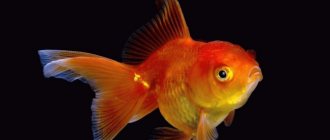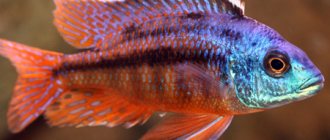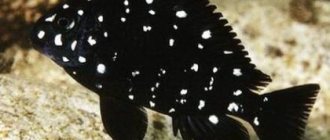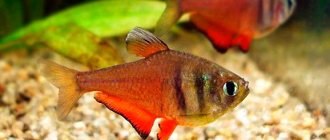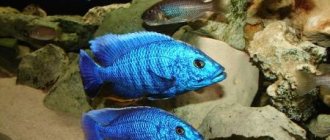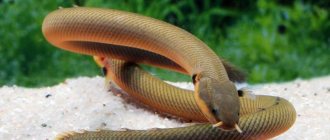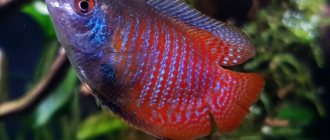Angelfish (lat. Pterophyllum scalare) is a genus of fish of the cichlid family (Cichlidae). They are one of the most popular and most widely distributed aquarium fish. It is a large, voracious fish that likes to eat fry and shrimp, although it is quite beautiful and has interesting behavior. Its tall and laterally flattened body, quite varied color and large size - all this made the angelfish one of the most common and popular fish among aquarists.
History and classification of angelfish
The name of the genus Pterophyllum was given by the Austrian zoologist Johann Jakob Haeckel (23 January 1790 – 1 March 1857) in 1840. It comes from the Greek words πτερος - “wing”, and φυλλον - “leaf” and literally means “winged leaf”.
But even before Haeckel, the scalar was described by two zoologists: Martin Heinrich Karl Lichtenstein (1780-1857) and Georges Cuvier (1769 - 1832) in 1823 and 1839, respectively, who gave it the specific name scalaris, but did not definitively determine the genus that needed clarification.
Haeckel is also credited with introducing the angelfish into a new, separate, single-species genus, Pterophyllum scalaris. After the revision in 1862, the generic name remained the same, but the ending in the species name, in accordance with the rules of the Latin language, was changed from "scalaris" to "scalare".
Later, two more species were added to it - Pterophyllum leopoldi and Pterophyllum altum. But scientists did not stop there; work in this direction continues to this day; according to some ichthyologists, the genus should consist of more species.
In English the fish is called “angelfish” - angel fish, for its high fins, in German the fish is “Segelflosser” (from the word “segel” - sail), in Spanish Peces ángel or Escalares.
The fish were first introduced to the general public in 1911 and were developed in Germany in 1914, on the eve of the First World War. In those days they were very expensive, and the method of their breeding was kept in the strictest confidence. And only a few years later, many Western aquarists of that time mastered its breeding.
Having mastered the breeding method, many aquarists did not stop there, starting work on selection. Since the growing popularity of fish every year required new shapes and colors.
Breeding work with angelfish has become so large-scale that today the numerous color forms of this species are taken for granted by everyone.
Types of angelfish
There are currently three species in the genus: Pterophyllum scalare, Pterophyllum altum and Pterophyllum leopoldi. At the moment, it is quite difficult to understand which species is now the most common in the aquarium hobby, since crossing has played a role.
Altum angelfish (Pterophyllum altum)
Pterophyllum altum or angelfish altum (Pellegrin, 1903). It is found strictly in the Orinoco River basin and the upper Rio Negro watershed in southern Venezuela, southeastern Colombia and the far north of Brazil. This species is the largest representative of its genus, and specimens can be up to 38 cm in height (from the tip of the dorsal fin to the tip of the anal fin).
Also characteristic is a sharp transition between the forehead and mouth, forming a depression. There are red dots on the fins.
For many years this species could not be bred in captivity, but in recent years it has been possible to obtain altum fry and in many countries they are bred for sale.
Pterophyllum scalare or common angelfish (Lichtenstein, 1823), habitat: large and small rivers of the Amazon basin (in Peru, Colombia and Brazil). This is the most common species in the aquarium trade.
Leopold angelfish (Pterophyllum leopoldi)
Pterophyllum leopoldi or Leopold's angelfish (JP Gosse, 1963), habitat: Amazon River basin (between Manakapuru and Santarem), Essequibo River and Rupununi River. It differs from other representatives of the genus Pterophyllum by the presence of a black spot at the base of the dorsal fin on the 4th vertical ray. There are a couple of black stripes on the body, and one on the dorsal fin, but not extending onto the body. Significantly different in head shape.
Rarely found, very similar to the common angelfish.
Angelfish (Pterophyllum scalare)
Probably the majority of angelfish sold today belong to this species. Traditionally considered the most unpretentious and easy to breed.
History of appearance
The first information about the fish can be found in 1823 in the work of the German scientist Schultz. It got its name thanks to the Australian zoologist Heckel in 1840. European residents were able to get acquainted with it only in 1920 and begin to successfully breed it at home; before that time, all imported representatives of the species died. The angelfish came to the United States in 1930.
At the beginning of the twentieth century, almost no one could figure out how to breed these fish, so they were considered very valuable and rare. For the first time in 1914, in Hamburg, it was possible to provoke their spawning by accidentally increasing the water temperature in the aquarium to 32 degrees.
Living in the wild
Angelfish is a freshwater tropical fish. The fish prefers slow-moving waters in South America: in the central basin of the Amazon River and its tributaries in Peru, Brazil and Colombia. In particular, the Ucayali River in Peru, the Oyapoc River in French Guiana, the Essequibo River in Guyana, the Solimões, Amapá and Amazon Rivers in Brazil. It is found in swamps or flooded lands where the vegetation is dense and the water is clear or cloudy. Water parameters vary from pH 6.0 to 7.0, water hardness from 3 to 10 °dH, and water temperature ranges from 26 to 30 °C.
In the wild, the fish live in densely planted areas where they feed on juvenile fish, insects, invertebrates and plants. They prefer ponds and rivers with slow flows and dense vegetation. The reservoirs in which angelfish live are characterized by warm, soft and slightly acidic water.
The flattened shape of the body allows them to easily maneuver among thickets of underwater plants, and the vertical dark stripes make them less noticeable to predators. In nature, fish usually gather in small schools.
Appearance and features
Photo: Common angelfish fish
The common angelfish has the following species characteristics:
- The body is tall, narrow, laterally flattened. The head has the shape of a triangle, with large red eyes on the sides;
- The size of the fish is average, the length of adults is up to 12-15 cm, and the height is up to 20 cm. The male and female are almost identical in parameters, the male is slightly larger;
- The dorsal and anal fins are elongated with pointed ends, due to which the appearance of the fish resembles a crescent. The pectoral fins look like long antennae;
- The body color of the common angelfish is silver-gray with a slight blue tint, against which four dark vertical stripes stand out; The first stripe crosses the eyes of the fish, the last one runs in the area of the caudal fin. The back is a darker shade.
Interesting fact: “The common angelfish is capable of changing the color of the vertical stripes on its body to a paler one. This transformation happens to her in stressful situations.”
Males and females differ little from each other. As adults, the male has a longer dorsal fin and has a fat sac on his forehead, so his forehead is rounded, while the female's is flat. Noticeable distinctive features appear only during the breeding season. The male has a pointed and narrow vas deferens under the abdomen, and the female has a wide ovipositor.
Description
Fish that live in nature have a silvery body with dark stripes. Laterally compressed body, with large fins and a pointed head. Long thin rays may develop on the caudal fin of mature fish. This shape helps them camouflage among roots and plants. This is why the wild form has a coloring in the form of vertical dark stripes.
Adult fish reach 15 cm in length and up to 25 cm in height. The average lifespan of an angelfish is 10 years, but there are cases when they lived 15 years or more.
However, describing the angelfish that are currently on sale is quite a difficult task. As a result of the breeding work of amateurs, a huge number of color variations were obtained - from golden to black angelfish. Today, the most popular are combinations of two or more colors (for example, koi angelfish or red devil angelfish) or unusual colors (blue angel angelfish, Pinoy angelfish).
Below is a photo of an angelfish, but this is only a small part of the variety that can be found in amateur aquariums.
Aquarium mates
Aquarium fish, angelfish, are considered sociable fish, but can be aggressive towards fish.
Christmas tree neighbors. While angelfish are young, they are quite peaceful, but as they age, they become a territorial fish. When they pair up, they become aggressive and fiercely defend their breeding territory.
Avoid proximity to aggressive biting fish - they can encroach on the “wings” (fins) of the angels.
Difficulty in content
Of average complexity, but not recommended for beginner aquarists, as they require decent volumes, stable water parameters and can be aggressive towards small fish. In addition, they hunt fry and small shrimp with remarkable dexterity. If there is a lack of experience in keeping them, they die or actively eat other fish, causing negative feelings in the novice aquarist.
They themselves may also suffer from fish that break off their fins, such as Sumatran barbs and thorns.
What to feed the zebra angelfish?
The fish are omnivorous and absolutely unpretentious when it comes to food. Hamsters, both live and specialized food. As for branded foods, we recommend using time-tested Tetra foods. You can find out detailed information about them on the company’s official website - here .
Whatever your choice of food for aquarium fish, when purchasing, be sure to look at the expiration dates of the product, and do not buy food in bulk or in damaged packaging. Like any product, fish food deteriorates and if storage conditions are violated, pathogenic flora develops in it.
Keeping in an aquarium
The fish are fairly undemanding and have a lifespan of over 10 years if they have the right conditions. It is better to keep it in a group of 6-10 individuals. There is a certain hierarchy in a school of fish - larger specimens occupy the best places in the aquarium, but at the same time you can safely add younger fish to the school. As practice shows, adult angelfish treat them calmly. In general, the more individuals in a flock, the less intraspecific aggression. If there are 10 or more fish in a group, the attention of dominant individuals will be scattered, and the pursuit of weak ones will be minimized.
Despite their peaceful nature, they are capable of showing aggression towards small fish species, perceiving them as potential prey.
Aquarium volume
Due to their shape, tall aquariums with a volume of at least 120 liters are preferred. However, if you are going to keep several of these beautiful fish, it is better to get an aquarium of 250 liters or more. Another benefit of buying a spacious aquarium is that it makes parents feel calmer and does not eat their eggs as often.
Also, it is a tall fish and you need a fairly tall tank to keep it. The minimum is an aquarium with a water column height of 40 cm.
Aquarium setup
By nature they are very shy fish. Sudden movements near the aquarium, turning electric lights on and off, as well as loud noises can frighten the fish; the reaction to this can be sudden throws in different directions, as a result of which the fish are injured by hitting the decorations and walls of the aquarium.
The decor in the aquarium can be anything, but preferably without sharp edges that could injure the fish.
Plants and angelfish
Despite the fact that most sources indicate that angelfish are completely compatible with aquarium plants, this is not the case. Adult fish happily pull out fast-growing plants with a weak root system (for example, hemianthus micranthemoides and needle-shaped sycamore) from the ground. If this happens, add some fish food containing spirulina to your diet.
And they defeated their attempt to attach moss to a snag very easily. Regularly plucking Java moss one branch at a time. It’s difficult to say why they behave this way, but, apparently, out of boredom and a voracious appetite.
In an aquarium with freshwater angelfish, you need to keep plants that have a strong root system, for example Echinodorus. It is advisable to plant plants with wide leaves in the aquarium, such as nymphs or Amazons; they like to lay eggs on such leaves.
The preferred daylight hours are from 8 to 12 hours.
Water parameters
In the wild, the fish lives in slightly acidic and fairly soft water, but nowadays it adapts quite well to any conditions. Today they are no longer as capricious as before, and are able to live in a wide range of temperatures and water chemistry.
Let me remind you that this is a freshwater tropical fish and water temperature is very important. The optimal water parameters for keeping angelfish are the following: water temperature from 26 to 30°C (75 to 86°F), hardness from 3 to 10°dH, pH 6.0 - 7.0. Nitrate levels should be kept below 100 mg/L.
Fish are able to tolerate a short-term drop in water temperature to 18-20°C, but do not abuse it.
Filtration
The body structure of the angelfish is not adapted to swimming in strong currents, and filtration in the aquarium should be moderate. A large flow of water causes stress and slows down the growth of fish as they spend energy fighting it. You can often see how a flock takes refuge from the flow of water from the filter, hiding behind snags, bushes or swimming into a corner.
It is wise to use an external filter and supply water through a flute or an internal one and spray the flow.
Weekly water changes are required, about 20% of the volume. Angelfish are very sensitive to the accumulation of nitrates and ammonia in water. This is one of those fish that likes fresh water and plenty of changes. Many breeders practice 50% water changes in the aquarium, and if they are breeding or raising fry, this becomes a daily procedure.
Species diversity
Subspecies of South American cichlids have many popular names. Below is a description of some of them.
Common angelfish
The average size of one of the most common fish in pet stores is 22 cm. Due to the shape of its fins and silvery color, it is often called the “moon fish.”
Adults are distinguished by a dark accent on the forehead and back. Despite its wide distribution in specialized stores, breeding forms of angelfish have pushed this species into the background.
Leopold's angelfish
It is distinguished by its relatively short body length - no more than 15 cm. Due to the length of the front part of the body, it is called “long-nosed”. Pterophyllum leopoldi does not have a bright color; even dark stripes are difficult to see on the dull brown fabric. This species has more proportional fins than those of the common angelfish, so it looks more harmonious. During breeding, a school of 6-7 fish divides in pairs, and after the fry hatch, they are reunited again.
Diamond
This species is related to the golden angelfish. It has a fascinating bright silver color. Some individuals have dark stripes. Pterophyllum scalare diamond deserves its name precisely because of the color of its scales, which play beautifully in the light, as well as its almost transparent fins. It is very popular among breeders who are actively trying to develop new breeds using it.
Angelfish bicolor
A distinctive feature is body color. It is dominated by two colors - silver and black. There are no stripes, instead there is a clear boundary between light and dark tones. If it happens that Scalare bicolor suddenly shows stripes, it immediately noticeably loses in price compared to its traditional counterparts.
Angelfish altum (or high-melting)
In the wild, some individuals had a profile reaching 45 cm in height. The appearance of Pterophyllum altum is very similar to the common angelfish, except for a more distinct pattern. This gracefully finned breed loves space and can be irritated by small, crowded aquariums.
Platinum angelfish
It owes its nickname to its light silver shining color.
Blue Angel
The blue angelfish, beloved by many, is more valuable if it has a more saturated hue. Scalare blue admirers prefer individuals without dark stripes. The cost of one fish with translucent blue fins reaches almost one and a half thousand rubles.
Golden angelfish
Despite the precious name, the ancestors of this species are the most common angelfish. The golden rock is unpretentious and is painted a pale silver color with golden areas. There may be very little yellow tint, or, on the contrary, it may occupy a significant part of the body, which is framed by large fins.
Leopard angelfish
This type of angelfish is painted in black and silver shades in a ratio of 50 to 50. It is thanks to the bizarre shape of the black spots that the fish received such an elaborate name. The breed is not at all suitable for living in dense places; for a comfortable life it needs free space.
Koi angelfish
The white canvas of their body is decorated with black strokes, and the head (sometimes other parts of the body) has a shade from orange to bright red. The smaller the bright spot, the more expensive the angelfish. Due to the coloring, similar to koi carp, this breed acquired the name Koi angelfish. Interestingly, it is difficult to find two individuals with the same coloring.
Red Devil
The red spots present in the Koi angelfish gave rise to a new breed. The fish has an ominous name, but it is very peaceful and not at all dangerous. There are practically no spots of a different color on the body of individuals, and the most expensive specimens are those with a complete absence of all colors except red.
Marble angelfish
They appeared from the species of common angelfish. Unlike its parent, the marbled species is smaller in size. In addition, these unpretentious angels are easier to keep than other breeds. The color contains silver and black colors, stripes, spots of different shapes. The fish received its nickname precisely for the combination of spots reminiscent of the rock of the same name. An aquarium with a capacity of more than 60 liters will be a suitable home environment for her.
Zebra (striped angelfish)
Like the wild horse breed, its color is replete with black stripes. It may seem that it is very similar to the most common type. This is true, the difference is that the stripes on the zebra’s body are more clearly defined. There are more than four of them on the body of these individuals.
Black angelfish
A widespread species, since it was bred by breeders many years ago. To breed pure black fish, individuals with extensive black spots were selected. It took a lot of work to get a perfectly black cichlid. Sometimes you can still find “black velvet” with areas of silver and gray shades. Typically these spots are located on the abdomen and fins.
Angelfish pink glowing
Breeders have nothing to do with it; the species appeared thanks to genetic engineering. was able to create a stunning pink glow-in-the-dark fish. Due to the high cost, few people purchase the radiant beauty, so it is not particularly widespread in Russia. There are unverified rumors that the pink angelfish lives very little and cannot have offspring.
Angelfish dantum albino
Graceful and smoothly moving descendants of Rio Nanay. It has long sailing fins, thanks to which the height of the fish can reach 27 cm. This white angelfish is photophobic and does not see very well. She will like aquariums with many grottoes, stones and areas shaded by plants. Albins are not known for their sociability; the best neighbors will be a few individuals of the same species.
Veiled angelfish
This breed is famous for its curved translucent fins. They have an elongated shape and can be painted in different colors and have different patterns. Since fins attract the attention of aggressive fish, angelfish should be isolated from Sumatran barbs, macropods and large cichlids. However, inhibited veil individuals irritate even neon and minor colors. Ideal companions would be bottom species (since angelfish love to be on the surface of the water and almost never sink to the bottom), as well as goldfish.
Pearl
Freshwater angels owe their iridescent color to genetics. The fact is that pearliness is not a distinctive feature of a selective species, but a manifested recessive gene. Dark-colored angelfish, unlike light-colored ones, rarely boast of this quality, since the iridescent highlights are invisible on their scales.
Paraiba angelfish (phantom)
This is the name given to fish that have a double gene for asexuality. Sometimes blue pearl angelfish are called by this unusual nickname.
Jacobin
Their feature is a more elongated body shape coupled with wide fins.
Birch
It is distinguished by clearly visible vertical stripes and is painted silver.
Dwarf
This is, rather, not a form, but sometimes mini-fish. Perhaps their growth is affected by improper feeding or insufficiently thought-out living conditions.
Feeding
Fish prefer to feed on the surface of the water, but without any problems they take food in the middle layers of the aquarium and lift it from the bottom.
What to feed? Angelfish are omnivores; they eat any type of food in an aquarium: live, frozen and artificial.
The basis of feeding can be high-quality flakes, and additionally give live and frozen food: tubifex, bloodworms, brine shrimp, and coretra. It is important to know two things, they are gluttons and cannot be overfed, no matter how much they ask.
And give bloodworms very carefully, and it is better to refuse it altogether. A slight overfeeding of bloodworms, and their intestines begin to bloat, so much so that pink bubbles stick out from the anal bladder.
It is much safer to feed with artificial food, since it is now of high quality.
What diseases do Marble Angelfish have?
Angelfish have many diseases; we will describe the main diseases, their symptoms and treatment.
Gill flukes in angelfish symptoms
Poor appetite. Redness of the gills. Fading of color. The fish often spends time at the surface of the water, head up. Treat by increasing filtration. Addition of drugs based on praziquantel: azipirin, Azinox-Plus and others.
Worms in angelfish
The fish doesn't eat. The appearance is emaciated, while the abdomen is swollen. Moves little. Redness of the eyes. Treat by adding anthelmintics to the water.
Hexamitosis in angelfish: signs and treatment
Poor appetite. Abdominal bloating. Darkening of color. Erosion of the scalp, formation of ulcers. Destruction of fins. Treat by increasing the temperature in the aquarium +34-35° C. Increased air supply. Adding metronidazole to water.
Ammonia poisoning symptoms in fish
Darkening of the body. Redness of the gills. Unusual behavior: moving sideways, trying to jump out of the aquarium. Treat with increased water changes up to 2 per week. One change must be made immediately. Increase filtering. Add a little hydrogen peroxide to the water.
Compatibility
Angelfish can be kept in a community aquarium, but you need to remember that it is still a cichlid, and it can be somewhat aggressive towards small fish. The same goes for fry and shrimp, they are magnificent and insatiable hunters; in my aquarium they wiped out countless hordes of cherry shrimp.
Who can keep cichlids with? With large and medium-sized fish, it is advisable to avoid very small ones, such as cardinals and microrasbor galaxies, although for me they live wonderfully with neons. The most interesting thing is that others greedily eat these same neons. Apparently the size of the fish matters. If they can swallow it, they will certainly do it.
You definitely need to avoid barbs and preferably any barbs other than cherry ones. In my practice, a flock of Sumatran barbs did not touch them at all, but a flock of fire barbs almost destroyed their fins within a day. Although you think it should be the other way around. Fins can also be gnawed by thornets, tetragonopterus, black barb, Schubert barb and denison.
You can keep them with viviparous animals: swordtails, platies, mollies, even with guppies, but keep in mind that in this case you should not count on fry. Also marble gourami, pearl gourami, moon gourami, congo gourami, erythrozonus and many other fish.
Is it possible to keep angelfish and goldfish together? Keeping these fish together is a mistake. Goldfish need cooler water, and angelfish need cleaner water (goldfish are constantly digging in the ground and picking up waste). I don't recommend keeping them together.
Often these fish are placed in an aquarium with discus fish, which is also not entirely correct, since the high temperature in aquariums with discus fish differs from the most comfortable temperature for angelfish.
Reproduction
The aquarium fish Leopold's angelfish reaches sexual maturity at approximately one year. In a teenage pack, pairs are formed based on mutual sympathy. Eggs are deposited on objects with a flat surface, or on the wide leaves of artificial or living plants. Both parents monitor the development of the eggs, caring for them. At a temperature of 29-30 degrees, pH from 6 to 7 and hardness of 10, eggs develop from two days to 70 hours. On days 4-5, the larvae become fry and can feed on their own. They need to be fed small plankton.
It is important to know that in any stressful situation in the aquarium, parents are able to eat their eggs. It is better to transfer the eggs to an incubator for further development, and remove the parents.
Sex differences
How to determine gender? It is impossible to distinguish between males and females before the onset of sexual maturity. And even then, it can only be reliably understood during spawning, when the female develops a thick, cone-shaped ovipositor.
Indirect signs are deceptive, the male is lobbier and larger, especially since females can create a pair if there are no males. And this pair will behave in exactly the same way, right down to imitation of spawning. So you can only determine the sex of adult fish, and even then with some relativity.
How to distinguish a male Marbled Angelfish from a female
There are many signs by which you can distinguish individuals of the opposite sex in a pair of angelfish. Males of the same age are much larger. The male's forehead is convex, the female's forehead is sunken. The front fin of female angelfish is smooth, while in the opposite sex it is forked. Number of stripes on the dorsal fin: female up to 6 stripes, male from 7 stripes.
Natural enemies of common angelfish
Photo: Male angelfish
Living in the rivers of the Amazon, the common angelfish encounters its natural enemies there. Since the fish is relatively small in size, it can become prey for both large fish species and medium-sized representatives of river fauna.
These fish include:
- piranhas, which are particularly voracious and have very sharp teeth, with which they can even bite a finger or a stick;
- Payara is a little-known fish that has two pairs of sharp teeth, one pair of which is visible, and the other is folded inside the jaw, and also has a good appetite;
- Aravana is a large predatory fish, lives in the backwaters of rivers with stagnant water and feeds on the fish living there.
Caimans can also be classified as enemies of angelfish. Due to their small size, they often have to rely on small fish as a source of food. In the struggle for life, the angelfish was able to adapt in the process of evolution.
Her main “trump cards” in the battle with enemies are:
- flattened body for easy maneuvering between algae;
- strong, long fins that allow you to quickly develop high speed;
- Vertical contrasting stripes on the body help camouflage among algae thalli.
